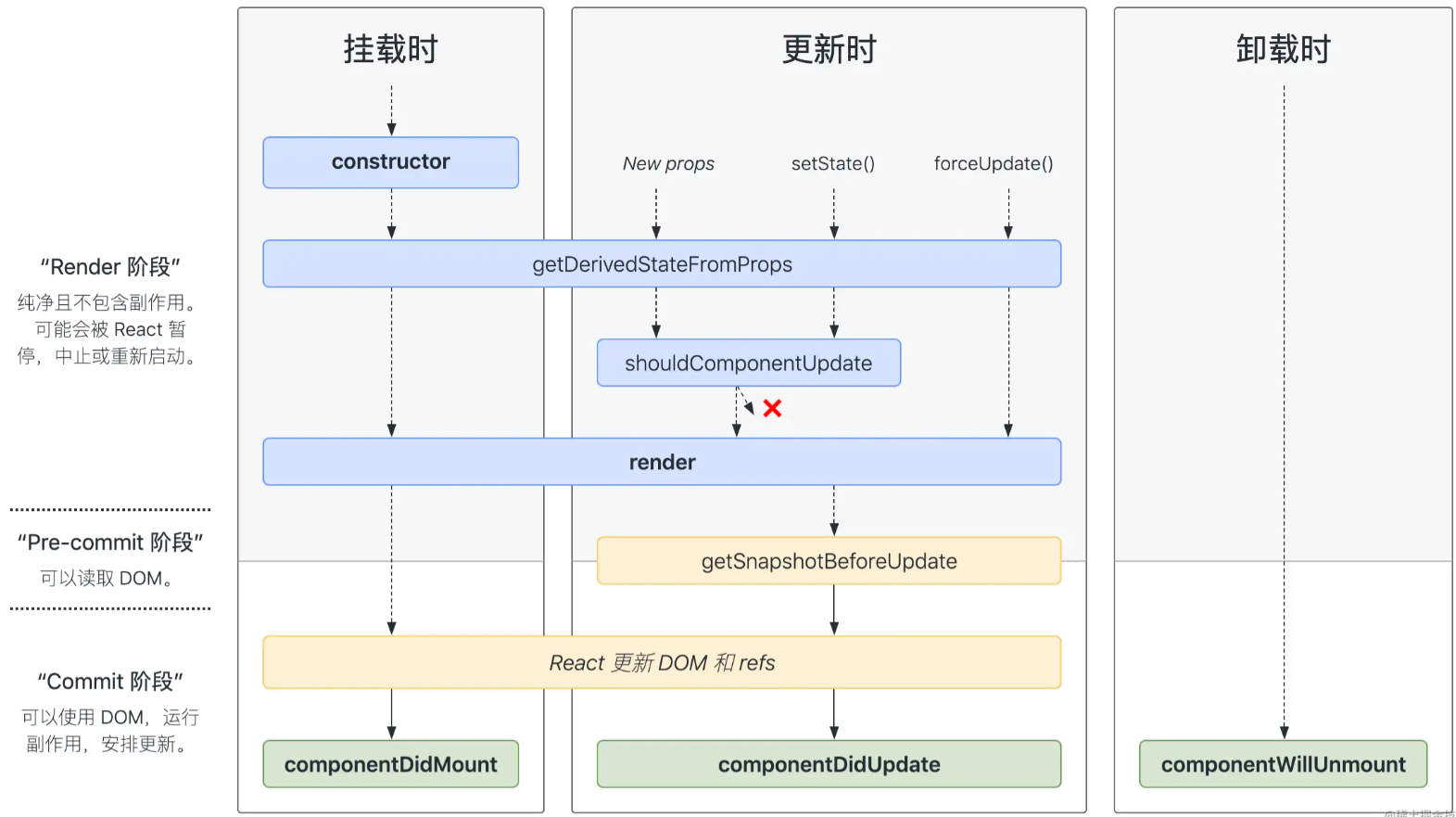1. 阻止默认行为和事件冒泡
1. preventDefault
preventDefault它是事件对象(Event)的一个方法,作用是取消一个目标元素的默认行为。既然是说默认行为,当然是元素必须有默认行为才能被取消,如果元素本身就没有默认行为,调用当然就无效了。当Event对象的cancelable为false时,表示没有默认行为,这时即使有默认行为,调用 preventDefault也是不会起作用的。
<a href="http://www.cnf2e.com/" id="testA" >cnf2e</a>
var a = document.getElementById("testA");
a.onclick =function(event){
//阻止默认行为
event.preventDefault();
}
2. stopPropagation
stopPropagation也是事件对象(Event)的一个方法,作用是阻止目标元素的冒泡事件,但是会不阻止默认行为。什么是冒泡事件?如 在一个按钮是绑定一个”click”事件,那么”click”事件会依次在它的父级元素中被触发 。stopPropagation就是阻止目标元素的事件冒泡到父级元素
<div id='div' onclick='alert("div");'>
<ul onclick='alert("ul");'>
<li onclick='alert("li");'>test</li>
</ul>
</div>
// 上面的代码,我们单击test时,会依次触发alert(“li”),alert(“ul”),alert(“div”),这就是事件冒泡。
<div id='div' onclick='alert("div");' >
<ul onclick='alert("ul");'>
<li id='ul-a' onclick='alert("li");event.stopPropagation()'>a</li>
</ul>
</div>
// 这时单击”test”,只会提示alert(‘li’);
2. 创建组件
1. 类组件
import React from 'react';
class MyComponent extends React.Component {
render() {
return <h1>Hello {this.props.name}!</h1>;
}
}
function App() {
return (
<div>
<MyComponent name="John" />
<MyComponent name="Mike" />
</div>
);
}
2. 函数组件
function MyComponent(props) {
return <h1>Hello {props.name}!</h1>;
}
function App() {
return (
<div>
<MyComponent name="John" />
<MyComponent name="Mike" />
</div>
);
}
3. 生命周期
在谈 React 生命周期时,主要谈的是 类式组件的生命周期,因为函数式组件是没有生命周期函数的。
组件从 被创建 到 被销毁 的过程称为组件的生命周期。
1. 生命周期状态与阶段
状态:
- Mounting(挂载时)
- Updating(更新时)
- Unmounting(卸载时)
阶段:
- Render: 用于计算当前的状态/更新信息,会根据产生的任务的优先级,安排任务的调度(schedule)
- Pre-commit: commit 之前,可以获取当前 DOM 的快照(snap)
- Commit: 把所有更新都 commit 到 DOM 树上

2. 组件挂载时
当组件实例被创建并插入 DOM 中时,其生命周期调用顺序如下:
- constructor()
- static getDerivedStateFromProps()
- render(): class 组件中唯一必须实现的方法
- componentDidMount()
3. 组件更新时
当组件的 props 或 state 发生变化时会触发更新。组件更新的生命周期调用顺序如下:
- static getDerivedStateFromProps()
- shouldComponentUpdate()
- render()
- getSnapshotBeforeUpdate()
- componentDidUpdate()
4. 组件卸载时
当组件从 DOM 中移除时会调用方法:componentWillUnmount()
4. set width in percentage in react-table
获得widget的宽度,通过计算的方式设置width
const getColumns = () => {
return [
{
Header: 'Name',
accessor: 'name',
id: 'name',
width: Math.round((window.innerWidth - 55) * 0.2),
disableFilters: true,
},
{
Header: 'Age',
accessor: 'age',
id: 'age',
width: Math.round((window.innerWidth - 55) * 0.2),
disableFilters: true,
},
{
Header: 'Visits',
accessor: 'visits',
id: 'visits',
width: Math.round((window.innerWidth - 55) * 0.2),
disableFilters: true,
},
{
Header: 'Last Visit',
accessor: 'last_visit',
id: 'last_visit',
width: Math.round((window.innerWidth - 55) * 0.2),
disableFilters: true,
},
{
Header: 'Status',
accessor: 'status',
id: 'status',
width: Math.round((window.innerWidth - 55) * 0.2),
disableFilters: false,
},
];
};
谈谈 React V16.4 的生命周期
深入理解Java双冒号(::)运算符的使用
Java Lambda 表达式
Java 8 Optional 类
PREVIOUSReact Hooks
NEXTClangd的使用